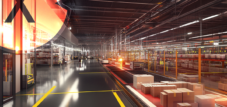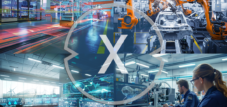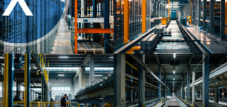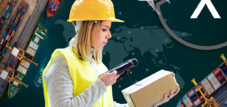The Internet of Things is revolutionizing logistics: real-time data in production, industrial and warehouse halls as the key to success
Language selection 📢
Published on: November 6th, 2024 / Update from: November 6th, 2024 - Author: Konrad Wolfenstein
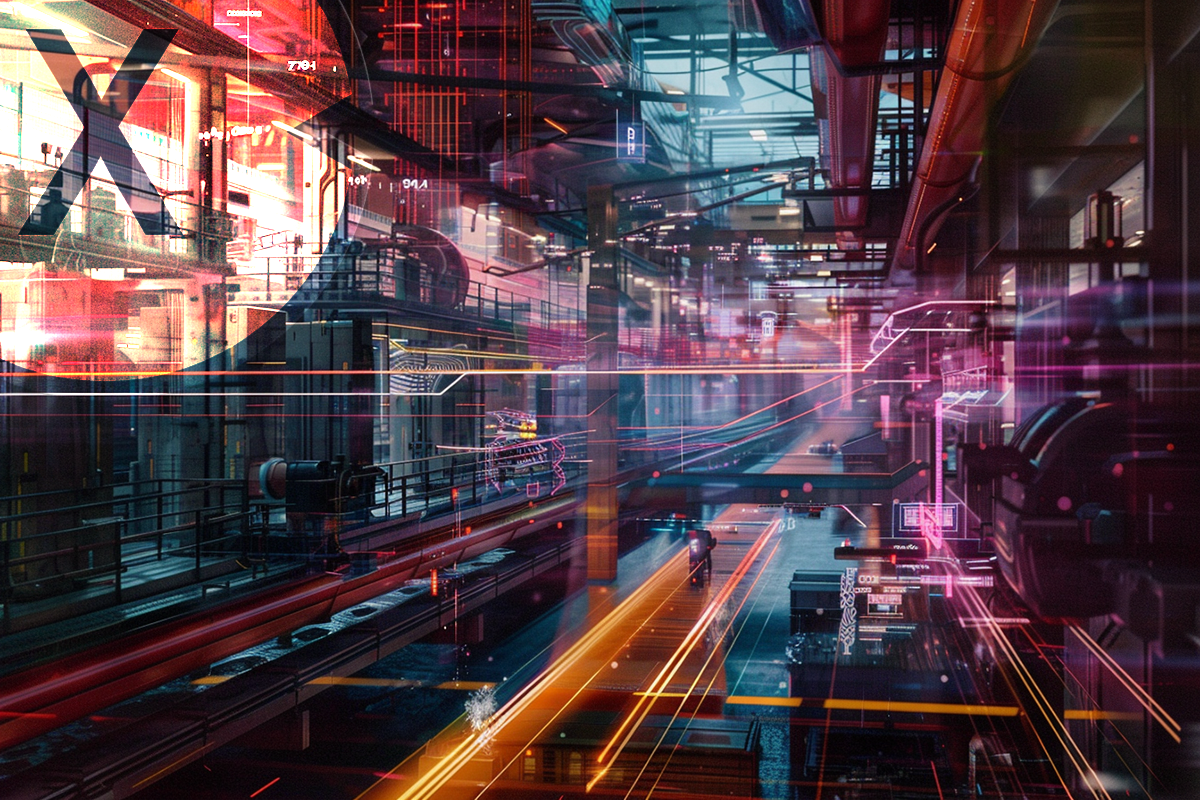
The Internet of Things is revolutionizing logistics: real-time data in production, industrial and warehouse halls as the key to success - Image: Xpert.Digital
🌐 The Internet of Things is revolutionizing the industrial and logistics sector
📊 The Internet of Things (IoT) is revolutionizing the logistics industry and setting new standards in terms of efficiency, security and flexibility in the supply chain. In an increasingly globalized world, the logistics industry is under constant pressure to optimize processes and adapt to increasing requirements. IoT technology offers completely new opportunities to monitor and adjust operations in real time, resulting in enormous benefits for both companies and customers.
❤️🔥 Real-time monitoring as the heart of modern logistics
The core of IoT initiatives in logistics is real-time monitoring of all operational processes. In warehouses, sensors are used on devices such as scanners, transport and loading units, which continuously provide data about the status of the devices, the utilization and the positions within the warehouse. This information is not only collected, but also visually processed and displayed, for example, in the form of heatmaps. Graphical representations like this make complex processes and possible bottlenecks visible quickly and clearly.
This visualization enables those responsible to immediately see where resources are being used particularly heavily and in which areas there is a need for optimization. In this way, bottlenecks and overloads can be identified early on and eliminated through targeted process adjustments. The efficiency of the entire warehousing process is increased, resulting in better use of resources and a smoother process.
🔒 Improved workplace safety through IoT
Real-time monitoring not only offers benefits in terms of efficiency, but also increases employee safety. Sensors on industrial trucks such as forklifts and other machines monitor possible dangerous situations, such as when vehicles come too close to each other. Potential collisions or hazards can be detected early and reported to the employees involved using warning systems, which significantly reduces the risk of accidents.
Furthermore, real-time data collection can be used to identify safety areas in the warehouse that are particularly susceptible to accidents. By continuously monitoring and analyzing these areas, management can take appropriate measures to further increase employee safety.
📊 Use data to dynamically adjust processes
One of the greatest strengths of the IoT lies in the ability to not only analyze data retrospectively, but also to use it in real time. Companies can react dynamically to changes and adapt processes flexibly without having to wait for lengthy evaluations. Storage areas can be restructured in real time to ensure optimal utilization. This flexibility ensures a significant increase in efficiency while minimizing security risks.
In modern warehouses, IoT systems enable processes to flow seamlessly into one another and no resources are wasted. Adaptability leads to proactive logistics in which inventories, transport routes and loading processes are constantly optimized. In this way, companies can shorten their delivery times and avoid bottlenecks, which ultimately increases customer satisfaction.
🔗 The connected and intelligent supply chain as a vision
A fully connected and intelligent supply chain that reacts flexibly to changes and offers customers excellent service is the vision of many companies. IoT is key to realizing this vision as it enables comprehensive visibility and control across the entire supply chain. From goods receipt to storage and picking to shipping, all processes can be monitored and optimized in real time. This not only opens up new ways for companies to increase efficiency, but also enables the development of innovative, customer-oriented services.
Today, customers can track the status of their shipments in real time and receive precise information about the expected delivery time. This transparency results in a significantly improved customer experience as it meets the needs for flexibility and control. The ability to communicate delays at an early stage and offer alternative solutions strengthens customer loyalty.
🔧 Predictive maintenance: Reduce costs and minimize downtime
Another major advantage of IoT in logistics is the predictive maintenance of systems and devices. Sensors continuously monitor the condition of machines and detect potential problems before they cause failures. This early detection makes it possible to carry out maintenance measures in a targeted and timely manner, which minimizes downtime and extends the service life of the machines.
By reducing unplanned downtimes and optimizing maintenance intervals, costs are reduced significantly. The data from the sensors provides valuable insights into how the machines operate and makes it possible to identify weak points at an early stage. Proactive maintenance management ensures that the systems are always kept in optimal condition, which in turn contributes to increasing the efficiency of the entire logistics chain.
🌿 Efficiency and sustainability in focus
Digitalization and the IoT also offer opportunities to make logistics more sustainable. Through optimized use of resources, shorter transport routes and a reduced number of empty journeys, companies can reduce their ecological footprint. Continuous monitoring and analysis of energy consumption and emissions help to make sustainable decisions and reduce the environmental impact of logistics.
Green logistics is becoming increasingly important given society's increasing environmental awareness. More and more companies are turning to sustainable solutions to make their supply chains more environmentally friendly. The IoT provides important data that leads to better planning and more conscious use of resources. One example is the precise planning of truck routes to minimize fuel consumption and avoid unnecessary emissions.
⏳ Challenges and future prospects
Despite the many advantages, implementing IoT in logistics also comes with challenges. Integration into existing systems and processes can be complex and expensive. In addition, data protection and data security are important issues, as the collection and storage of large amounts of real-time data pose potential security risks.
To realize the full potential of IoT, companies must invest in a solid IT infrastructure and ensure that data is optimally protected. Training employees in how to use the new technologies is also essential to ensure an efficient and safe working environment.
Despite these challenges, the trend clearly shows that the future of logistics will be heavily influenced by the IoT. Companies that rely on these technologies and adapt their processes accordingly will have a competitive advantage in the long term. The increasing spread of the IoT will lead to further automation and increased efficiency and enable new business models.
🚛 The Internet of Things as a driver for a new era of logistics
The IoT has the potential to fundamentally change the logistics industry. Real-time monitoring and analysis of operational processes as well as predictive maintenance can significantly increase efficiency and safety. At the same time, the digitalization of the supply chain offers new opportunities for customer loyalty and the development of innovative services.
Companies that integrate IoT into their logistics processes benefit from a flexible and dynamic supply chain that responds to changes in real time and offers customers optimal service. The IoT also contributes to sustainability by enabling better use of resources and reducing environmental impact. Although implementation is challenging, the long-term benefits outweigh the challenges. The logistics of the future will be characterized by intelligent networking, efficiency and sustainability, and the Internet of Things will play a central role in this.
📣 Similar topics
- 📡 Real-time monitoring: key to efficiency
- 🚧 Security with IoT: Identify risks early
- 🔄 Flexible process adjustment thanks to IoT
- 🌐 The connected supply chain of the future
- 🛠️ Predictive maintenance for stable operations
- 🌱 Sustainability in logistics through IoT
- 🔍 Real-time data analysis for optimization
- 🚚 Improving customer experience through IoT
- 🚀 Challenges and opportunities of IoT integration
- 🌟 IoT as a pioneer of the new logistics era
#️⃣ Hashtags: #IoT #Logistics #Efficiency #Security #Sustainability
Our recommendation: 🌍 Limitless reach 🔗 Networked 🌐 Multilingual 💪 Strong sales: 💡 Authentic with strategy 🚀 Innovation meets 🧠 Intuition
At a time when a company's digital presence determines its success, the challenge is how to make this presence authentic, individual and far-reaching. Xpert.Digital offers an innovative solution that positions itself as an intersection between an industry hub, a blog and a brand ambassador. It combines the advantages of communication and sales channels in a single platform and enables publication in 18 different languages. The cooperation with partner portals and the possibility of publishing articles on Google News and a press distribution list with around 8,000 journalists and readers maximize the reach and visibility of the content. This represents an essential factor in external sales & marketing (SMarketing).
More about it here:
🚚🔗 The logistics industry is changing: IoT as the key to the future
🌐 Connected warehouses: Optimization through real-time monitoring and sensors
The logistics industry is faced with the constant challenge of accelerating processes, making them more efficient and maintaining the highest safety standards. In a world where delivery times are becoming shorter and customer requirements are becoming more specific, it is essential to integrate innovative technologies to remain competitive. This is where the Internet of Things (IoT) comes into play, which is considered a game-changing factor for the future of logistics.
A central area of application for IoT is the optimization of warehouses. By using networked sensors and devices, operational processes can be monitored and controlled in real time. The heart of this initiative is the continuous monitoring of operational processes. Sensors on scanners, transport and loading devices as well as data from the warehouse management system provide a constant stream of information. This data is not only collected, but also visually processed, for example in the form of heatmaps.
The graphical representation of the collected data enables a completely new perspective on the processes in the warehouse. Complex relationships become understandable at a glance, which makes decision-making much easier. The advantages of this technology are manifold: By visualizing the data, companies can optimize the use of their resources. For example, bottlenecks and overloads in certain warehouse areas are quickly identified and eliminated through targeted process adjustments.
🔒 Security standards and risk minimization through IoT technologies
Employee safety also benefits significantly from real-time monitoring. Possible dangerous situations, such as collisions with forklift trucks, can be identified and avoided at an early stage. By continuously analyzing the movement patterns of machines and people, risks can be minimized and work accidents reduced.
Another key advantage is that data is no longer only analyzed retrospectively. Instead, they are used in real time to dynamically adapt processes and optimally design the storage areas. This leads to a significant increase in efficiency while minimizing security risks.
🚀 Digitalization of the supply chain: new dimension of transparency and control
The digitalization of the supply chain has become a central part of the company's strategy. However, many companies are still hesitant to exploit the full potential of digitalization. The vision is a fully connected and intelligent supply chain that reacts flexibly to changes and offers customers even better service.
IoT technology makes it possible to increase transparency and control across the entire supply chain. From goods receipt to storage and picking to shipping, all processes can be tracked and optimized in real time. This not only leads to greater efficiency and security, but also enables the development of new, customer-oriented services. Customers can track the status of their shipments in real time and receive precise information about the expected delivery date.
🔧 Predictive maintenance: Reducing downtime and costs through sensor technology
In addition, the digitalization of the supply chain opens up new opportunities for the predictive maintenance and repair of systems and devices. Sensors record the condition of the machines and report potential problems at an early stage, before failures occur. This minimizes downtime and significantly reduces maintenance costs.
🤖 Artificial intelligence and machine learning: increasing efficiency through data analysis
The integration of artificial intelligence (AI) and machine learning into logistics IoT systems also enables the analysis of large amounts of data. This allows patterns to be recognized and forecasts to be created, which lead to further optimization of processes. For example, demand forecasts can be improved and inventories adjusted accordingly, leading to a reduction in storage costs.
🌱 Sustainability and environmental protection: Contribution of IoT to reducing emissions
Another important aspect is improving sustainability in logistics. Emissions can be reduced by using resources efficiently and reducing empty runs. The IoT makes it possible to optimize transport routes and calculate alternative routes in real time to avoid traffic jams and delays. The technology not only helps reduce costs, but also protects the environment.
🛡️ Challenges and solutions: data protection and employee training
However, implementing IoT solutions also presents challenges. Data protection and data security are critical aspects that must be taken into account. Companies must ensure that the data collected is protected and complies with legal requirements. Regular security updates and staff training are essential.
Employee training is generally a crucial factor for the success of digitalization. The introduction of new technologies requires a new way of thinking and a willingness to embrace change. Through targeted training, employees can be empowered to use the new systems effectively and take full advantage of the benefits.
🤝 Collaboration and innovation: partnerships as the key to competitiveness
It is also important to gain employee acceptance of the new technologies. Open communication about the advantages and effects of digitalization can help reduce reservations and increase motivation.
Collaborating with technology partners and start-ups can help companies develop innovative solutions and respond quickly to market changes. By sharing know-how and resources, customized IoT solutions can be implemented that meet the company's specific needs.
The Internet of Things offers enormous potential for the logistics industry. Real-time data makes it possible to optimize processes, increase security and improve customer service. Companies that are willing to invest in these technologies and make the necessary changes will gain a decisive competitive advantage.
📈 Future prospects: The logistics revolution through IoT
In an increasingly connected world, it is essential to adapt to technological developments. The IoT will continue to grow in importance in the coming years and open up new possibilities that may be unimaginable today. The future of logistics is connected, intelligent and flexible - and the Internet of Things is the key to it.
By using IoT in logistics, companies can not only increase their efficiency, but also make an important contribution to customer satisfaction and sustainability. It is up to companies to seize this opportunity and pave the way for a new era of logistics.
📣 Similar topics
- 📦 The revolution in logistics with the Internet of Things
- 🔗 Connected supply chains: The IoT advantage for logistics
- 🚛 Increasing efficiency in logistics through IoT technologies
- 📊 Real-time data as a game changer in the logistics industry
- 💡 Innovative technologies: The key to modern logistics
- 🧠 Artificial intelligence and IoT: A strong duo for logistics
- 🔍 Security and monitoring: IoT as a protective shield for logistics
- 🌿 Sustainability in logistics thanks to IoT innovations
- 🔐 Data protection and security in the digitalization of logistics
- 🤝 Partnerships in the technology sector: shaping the future of logistics
#️⃣ Hashtags: #Logistics #IoT #Efficiency #Sustainability #Security
We are there for you - advice - planning - implementation - project management
☑️ SME support in strategy, consulting, planning and implementation
☑️ Creation or realignment of the digital strategy and digitalization
☑️ Expansion and optimization of international sales processes
☑️ Global & Digital B2B trading platforms
☑️ Pioneer Business Development
I would be happy to serve as your personal advisor.
You can contact me by filling out the contact form below or simply call me on +49 89 89 674 804 (Munich) .
I'm looking forward to our joint project.
Xpert.Digital - Konrad Wolfenstein
Xpert.Digital is a hub for industry with a focus on digitalization, mechanical engineering, logistics/intralogistics and photovoltaics.
With our 360° business development solution, we support well-known companies from new business to after sales.
Market intelligence, smarketing, marketing automation, content development, PR, mail campaigns, personalized social media and lead nurturing are part of our digital tools.
You can find out more at: www.xpert.digital - www.xpert.solar - www.xpert.plus








